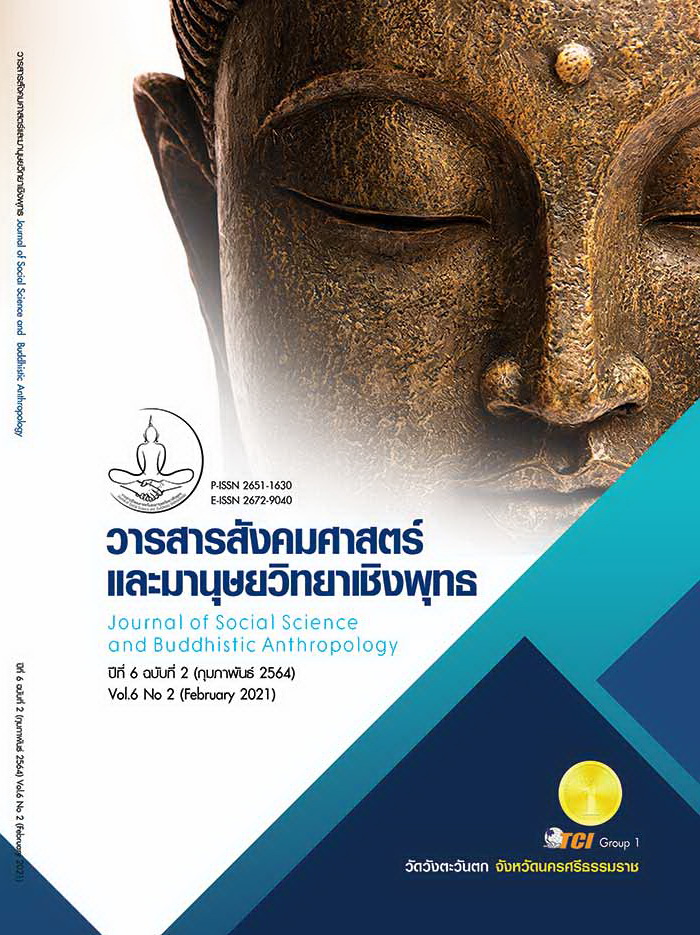THE STRATEGY OF CHAO PHRAYA RIVER TOURISM BUSINESS FOR CHINESE TOURISTS IN BANGKOK
Keywords:
Strategy, Tourism Business, The Chao Phraya River, Chinese TouristsAbstract
The Objectives of this research article were 1) to study the tourism of the Chao Phraya River demands of Chinese tourists in Bangkok, 2) to study the tourism business context and those involved in the tourism industry of the Chao Phraya River in Bangkok, and 3) to create a development strategy for the Chao Phraya River tourism business for Chinese tourists in Bangkok. The research and development are an integration of methods, by applying a questionnaire to a sample of 400 Chinese tourists. The statistical method that was used to analyze the data was by a stepwise multiple regression analysis with a significance level of 0.05. A group interview was conducted on 6 groups of the Chao Phraya River tourism business operators. The results of the analysis was used to create a strategy to develop the Chao Phraya River tourism business for Chinese tourists In Bangkok, in addition to organize brainstorming sessions to improve strategies. The results of the research may be briefly concluded, as follows: 1) Chinese tourists' demand for tourism on the Chao Phraya River are based on services, pricing, distribution channels, marketing promotions, personnel, physical attributes, and government policy; 2) the relationship between tourism industry marketing that has an effect on the decision of Chinese tourists to use the service consists of, services, physical attributes, business cooperation, pricing, distribution channels, government policy, personnel, and service processes; and 3) the strategy for the development of the Chao Phraya River tourism business for Chinese tourists In Bangkok may be classified into 5 primary strategies, namely strategies regarding services, physical attributes, pricing, distribution channels, and government policy, and 4 secondary strategies, which are strategies regarding human resource, business cooperation, marketing promotion, and service processes.
References
กระทรวงการท่องเที่ยวและกีฬา. (2560). ปลัดท่องเที่ยว "ห่วงใย เที่ยวเมืองไทย สุข สนุก ปลอดภัยทุกฤดูกาล". เรียกใช้เมื่อ 22 มกราคม 2563 จาก https://www.mots.go. th/News-view.php?nid=8498
กระทรวงการท่องเที่ยวและกีฬา. (2562). สถิตินักท่องเที่ยวภายในประเทศ Q1-Q4 ปี 2561 (ภาคกลาง). เรียกใช้เมื่อ 13 มกราคม 2563 จาก https://www.mots.go.th/old /more_news.php?cid=531& filename=index
กองเศรษฐกิจการท่องเที่ยวและกีฬา. (2562). สถานการณ์เดือนพฤศจิกายน 2562. เรียกใช้เมื่อ 23 มกราคม 2563 จาก https://www.mots.go.th/download/article /article_20200106115632.jpg
ชิณโสณ์ วิสิฐนิธิกิจา และคณะ. (2560). ปัจจัยทางการตลาดที่มีผลต่อการตัดสินใจเลือกบริษัทนำเที่ยวจีน ในการมาท่องเที่ยวในประเทศไทย. พิษณุโลก: มหาวิทยาลัยราชภัฏพิษณุโลก.
ชุติระ ระบอบ. (2562). ทัศนคติของผู้ให้บริการในโซ่อุปทานอุตสาหกรรมท่องเที่ยวที่มีต่อแนวทางการส่งเสริมพฤติกรรมเชิงบวกของนักท่องเที่ยวชาวจีนในประเทศไทย. สมุทรปราการ: มหาวิทยาลัยหัวเฉียวเฉลิมพระเกียรติ.
พินิตา แก้วจิตคงทอง และเยาวลักษณ์ ชาวบ้านโพธิ์. (2559). ปัจจัยที่ส่งผลต่อการเลือกใช้บริการการจัดประชุมและสัมมนา (MICE) ของธุรกิจโรงแรมและรีสอร์ทในจังหวัดกาญจนบุรี. วารสารวิจัยมหาวิทยาลัยเวสเทิร์น มนุษยศาสตร์และสังคมศาสตร์, 2(3), 35-46.
ภาวิดา ธนาธัญทวี. (2559). มิติกระบวนการตัดสินใจ: นักท่องเที่ยวจีนร่ำรวยเยือนประเทศไทย. ใน ดุษฎีนิพนธ์บริหารธุรกิจดุษฎีบัณฑิต สาขาการตลาด. มหาวิทยาลัยสยาม.
รสริน สุภารัตน์ และคณะ. (2557). พฤติกรรมนักท่องเที่ยวชาวจีนที่เดินทางมาท่องเที่ยวอำเภอเมือง จังหวัดเชียงราย. เชียงใหม่: มหาวิทยาลัยเทคโนโลยีราชมงคลล้านนา.
เลิศพร ภาระสกุล. (2558). แรงจูงใจและทัศนคติที่ส่งผลต่อความพึงพอใจโดยรวมของนักท่องเที่ยวชาวจีนต่อการท่องเที่ยวประเทศไทย. กรุงเทพมหานคร: มหาวิทยาลัยธุรกิจบัณฑิต.
ศิกษก บันลือฤทธิ์ และจิราภรณ์ กาญจนสุพรรณ. (2561). เรือกับการท่องเที่ยวเชิงวัฒนธรรม: กรณีศึกษาลุ่มน้ำเจ้าพระยาฝั่งธนบุรี กรุงเทพมหานคร. กรุงเทพมหานคร: มหาวิทยาลัยราชภัฏธนบุรี.
Aleksandr P. G., et al. (2016). Perspective Tools of the Strategic Management of VFR Tourism Development at the Regional Level. RUSSIA: Pyatigorsk State University.
Kanika Thakran and Rohit Verma. (2013). The Emergence of Hybrid Online Distribution Channels in Travel, Tourism and Hospitality. New York City: Cornell University.
Krungthai COMPASS. (2563). ทิศทางนักท่องเที่ยวจีนในอีก 10 ปีข้างหน้าจะเป็นอย่างไร? กรุงเทพมหานคร: ไทยพับลิก้า.
Ramazan Goral. (2016). Price Competitiveness of International Tourism Destinations and Tourism Demand, Tourism Receipts Relationship. European Journal of Multidisciplinary Studies, 1(2), 195-203.
Sadaf Alam, et al. (2017). Discriminant Analysis of Marketing Mix Factors’ in influencing the Use of Hotel Services in Pakistan. Journal of Business and Tourism, 2017(Special Issue), 143-152.
Wang, Y.P. (2015). A Study on Kinmen Resident's Perception of Tourism Development and Culture Heritage Impact. Xiamen China: Huaqiao University.
Jinting, W. (2017). Ethnic Tourism and the Big Song: Public Pedagogies and the Ambiguity of Environmental Discourse in Southwest China. Faculty of Education: University of Macau.








